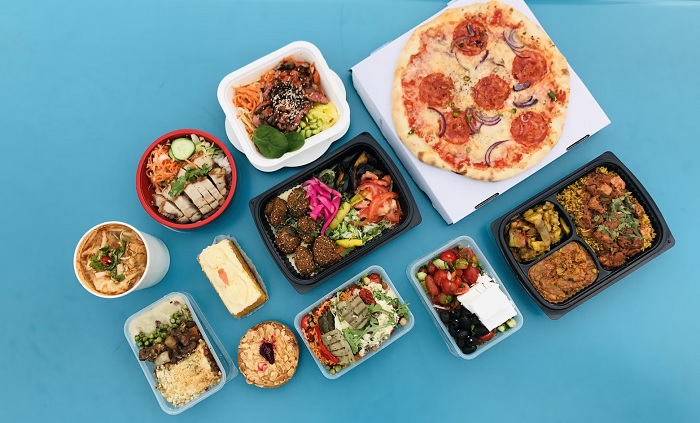Food & Beverage
7 Tech Innovations Revolutionizing Meal Delivery Services

- Cutting-edge technologies are revolutionizing meal delivery, making it faster, more personalized, and eco-friendly.
- Innovations such as AI-driven planning, drone deliveries, and smart kitchen integration are setting the stage for a future of seamless and sustainable food services.
Imagine your favorite meal, perfectly tailored to your diet, delivered right to your doorstep. Innovative technologies make this a reality now. They’re changing how we eat, one delivery at a time.
From AI-driven recommendations to sustainable packaging solutions, tech is turning the meal delivery industry upside down.
1. AI-Powered Personalized Meal Planning
AI is reshaping meal planning, making it more intuitive and personal. Imagine having a virtual chef who knows your taste buds better than you do.
For instance, HelloFresh uses machine learning algorithms to rank preselected menu options based on your previous choices. This means every meal suggestion feels just right for you.
With AI analyzing dietary preferences and nutritional needs, customized meal kits for low-carb diets or other specific requirements become effortless to acquire. It’s like getting a personal nutritionist for every delivery.
2. Eco-Friendly Packaging Innovations in Meal Delivery
In light of the growing advocacy for climate change action, meal delivery services are turning to eco-friendly packaging solutions. Companies now use biodegradable materials, cutting down on plastic waste significantly.
Some firms even experiment with edible packaging and compostable alternatives that leave no trace behind. This shift not only appeals to environmentally-conscious consumers but also aligns with broader sustainability goals.
As we push for a greener future, these innovations ensure our convenience doesn’t come at the planet’s expense.
3. Advanced Nutritional Tracking and Customization Tools
With tech advancing, tracking nutritional intake and customizing meal plans is easier than ever. Several innovative tools have emerged to support this shift.
- MyFitnessPal: This app logs daily food intake, breaking down nutrients to help you stay on track with your dietary goals.
- NutriSense: It uses continuous glucose monitors to provide real-time data on how different foods impact blood sugar levels.
- Cronometer: Offers detailed nutrient tracking beyond basic macros, giving insights into vitamin and mineral consumption.
These tools empower individuals to make informed dietary choices effortlessly.
4. Drone Delivery Systems Reducing Wait Times
Drone delivery is revolutionizing the speed of meal deliveries, slashing wait times dramatically. Companies are leveraging this tech to enhance customer satisfaction.
For example, Chinese shopping platform Meituan already uses drones to deliver meals swiftly in urban areas. This method bypasses traffic jams and reduces delivery times significantly.
Meanwhile, drone tech company Zipline plans to bring this innovation to U.S. cities like Detroit, Houston, and Seattle. With such advancements, getting your favorite dish delivered hot and fresh becomes faster than ever before.
5. Smart Kitchen Integration with Meal Kits
Smart kitchens are becoming the heart of meal kit services, enhancing convenience and cooking precision. Integrating IoT devices allows seamless coordination between meal kits and kitchen gadgets.
Picture a smart oven that preheats itself based on your delivery schedule or a fridge that tracks ingredients’ freshness automatically. These innovations not only simplify cooking but also reduce food waste, making home-cooked meals more enjoyable and efficient than ever before.
6. Virtual Reality for Interactive Cooking Experiences
VR technology has had many applications since its discovery back in the mid-1900s, and now it’s spicing up home cooking.
With VR, users can join and enjoy the perks of virtual cooking classes led by world-renowned chefs, right from their kitchens. These immersive experiences make learning new recipes fun and engaging.
Additionally, some meal delivery services offer VR-guided instructions tailored to their kits. This tech transforms meal prep into an interactive adventure, blending education with entertainment seamlessly.
7. Machine Learning Algorithms Enhancing Inventory Management
Machine learning is transforming inventory management in meal delivery services, ensuring efficient stock levels and minimizing waste.
These algorithms predict demand trends accurately, helping companies keep up with consumer needs. They also help in navigating the challenges associated with the shift from fast food to delivery services.
With their inventory optimized based on real-time data, businesses reduce costs and improve customer satisfaction through timely deliveries.
As these innovations continue to evolve, meal delivery services will only become more seamless and personalized. We’re on the brink of a future where technology ensures every meal fits our unique needs and is delivered swiftly and sustainably. Exciting times lie ahead for food lovers everywhere.























































